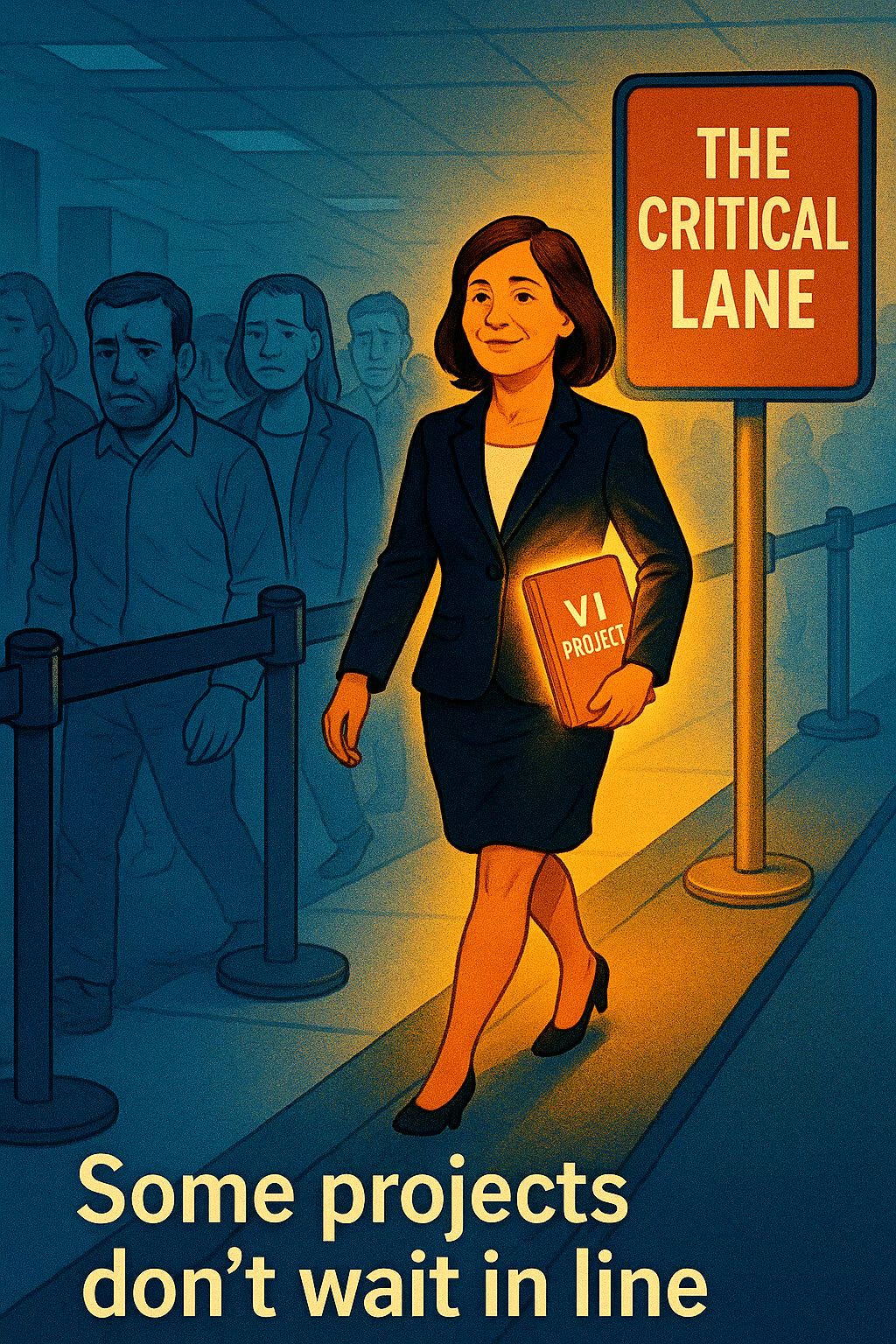Aggressive Dates Webinar Recording
How to deliver your strategic Agile projects faster — while your competitors stay stuck in traffic. The 13 moves.
Here's the recording of last week's Aggressive Dates webinar.
I shared the recipe for the secret sauce (and the 13 ingredients) you need to deliver your most important Agile projects on time - or, better, early - to surprisingly aggressive dates.
My approach is new, counterintuitive and obvious. It's not theory - I first used this approach 15 years ago to help one client make over £45M, and I've used it many times since. This is the first time I've codified it.
The short version: We take aggressive dates then change the system so they become slam dunks. How? By cheating - stacking the deck - in a good way!
You can watch it on YouTube, read the transcript (below), or watch here on substack: ↓
Here’s the transcript cleaned up by Claude.ai:
Opening and Welcome
Hello, hello, hello everyone! Great to see familiar names like Bruce and Rodrigo joining us from around the world. We've got about 40 people so far, and I'm expecting maybe 50 from the 100+ who registered.
As people join, let me say - if you need to leave early, feel free. If you want to make rude comments in the chat, go ahead! And Laz here is helping me co-host, so he'll mute anyone who accidentally unmutes themselves.
Let me get some thumbs up that I'm recording properly... excellent. And can everyone see my slides? Perfect.
Now, can you all look at the chat and say hello to Robbie, and tell us where you're joining from? I love seeing how global we are - Manchester UK, Scotland, Poland, Amsterdam, Luxembourg, Germany, Newcastle, Wellington, Yorkshire, the Netherlands, Finland, Jakarta, Berlin... we're very well-rounded today!
The Promise
We currently have 41 lovely people here to learn how to deliver agile projects to aggressive dates. That's the promise - delivering them fast without sacrificing quality.
We're definitely NOT going to do more estimating or planning. We're not making anyone work harder or weekends. We're not going to say we'll hit a date and then run over repeatedly. We're going to figure out how to deliver the most important projects on time to aggressive dates.
This isn't about every single project - this is about the most important ones. This is about management and making money. For a long time, I secretly called what I do "benefits engineering," but now I'm comfortable saying it's about making money. When you focus on commercial benefits, it makes many things better, especially if your business is struggling.
The Metaphor
You can see my slides aren't very serious looking. We have an angry fruit - an aggressive date - and next to it, an expensive leek. Both are metaphors. The expensive leek comes from our recent water bill being twice as high due to a toilet leak we didn't know about. It wasn't just water leaking - it was money leaking. Much of this is about using aggressive dates to stop money leaking from your business.
If I took a flippant view, I'd call this "The Adventures of Dollars and Deadlines" - our two main players. This is about deadlines done well (not badly like usual) and the output is dollars, often better products, and better workplaces.
The Problem with Current Agile
I've been doing Agile for a very long time and think it's wonderful - one of the world's great innovations. It's great at building working software, fast and flexible, putting people first.
But it's focused mostly on the delivery problem, not the money problem. Many Agile teams proudly say "we don't do deadlines," "we don't estimate value," and "we don't commit to ROI." I can understand why, but the consequences are that projects run late, value leaks out, and executives get nervous. This erodes trust.
It would be much nicer if we had a high-trust environment where we could have grown-up conversations. But we've burned a lot of trust as an industry, and executives look at agile and think "they're quite slow, aren't they?"
The CEO Story
Let me tell you a story that's mostly true. Many years ago, I was brought in to rescue a big agile project with about 200 people. After we got it on track, I got time with the CEO of this 4,000-person company.
I thought I was clever and asked: "Imagine you had a magic wand to wave over your IT division. If you had one wish, what would it be?"
I expected him to say he wanted projects delivered faster to make more money. Instead, he said: "Better technical architecture."
I was surprised, but now I understand. As CEO, he saw two worlds - one part that makes money, and another that spends money. IT was a huge spend, particularly on technical architecture.
When I suggested delivering projects in three-quarters of the time, he burst out laughing: "You folk can't deliver projects on time. What makes you think you could deliver them sooner?"
He'd been working with projects for 30-40 years and had never seen them not overrun. Our credibility was low.
Then he got serious: "Project XYZ was supposed to deliver eight months ago, and you guys say it'll take another four months. That 12-month delay has cost me £20 million in revenue. If it had shipped on time, we would have sold £20 million worth of new products."
He continued: "We needed that money. We wouldn't have invested in XYZ if we'd known it would overrun this much - we had other options. Worse, I predicted XYZ would only be six months late, so I publicly forecast higher profits. Our share price went up. When I announce this year's results, they'll be lower than expected, our share price will drop, and I'll look like a fool."
Finally: "Our competitors are kicking our asses. You computer geeks are too slow, and all you give me are technical excuses. I want a new wish - figure out how to deliver projects on time. Take deadlines seriously."
This isn't about stand-ups or pair programming - it's about the commercial aspects and what executives see from the outside.
Our Strategy
Our strategy has three parts:
Take deadlines deadly seriously - not like the usual lip service
Stack the deck - cheat like you're playing cards, moving the good cards where you need them. In business, this kind of cheating is legal and good.
Stop losing so much money
The term "deadline" comes from the American Civil War. When they took prisoners but had no prisons, they'd lay stones in a line around the camp. Stay inside the stones, you're safe. Cross the deadline, and they'd shoot you. Over time, this moved into journalism, then offices, then project management. We're going to take our deadlines seriously - not shoot anyone, but take them seriously so we don't have to.
The Benefits
Here's a before-and-after comparison. When delivering late, you have lost revenue, missed forecasts, burned trust with executives, opportunity costs, and teams trapped in stressful work.

When delivering aggressively early, you get earlier revenue, reliable forecasting and credibility, increased executive confidence, earlier starts on next projects, and teams that look and feel like heroes.
The amount of times I've seen projects become death marches with cancelled holidays and long hours - it's incredibly stressful. But when we switch to working with deadlines done well, teams can have a joyous experience. One client just last week told me switching to this approach made work "really invigorating and everyone loves it, and they're making a lot more money."
If you can deliver stuff on time in a way that's joyful and profitable, you'll build trust with executives. The next time they have a gnarly problem, they'll come to you because you'll have a reputation as a safe, inventive, clever pair of hands.
The 13 Moves
Here are the 13 moves organized in four columns and three levels:
Columns:
Mechanics - processes and mechanisms
People - three things you must do with people
Curation - figuring out what to do and what not to do
Trust - building and rebuilding trust
Levels:
Strategic Foundation - the most important strategic stuff
Operational Control - day-to-day operational things
Preventative Control - things that prevent problems
Move 1: Pick Your Deadline (The Wedge)
This is called "the wedge" - like putting a wedge in a cracked rock and hitting it with a hammer to split it apart. This sets everything else up.
Imagine you have a project and two dates in mind. Some people say "If we got really lucky, April 1st, we could probably ship then." Others say "You know how things are - December 1st to be safe."
Both are actually aggressive dates, but there's a lot of leakage between April 1st and December 1st.
Here's the magic - we shift that probability curve to the left and squeeze it tighter. What this means is we start with an aggressive date and turn it into a non-aggressive date through the other 12 moves.
We're NOT doing more estimating, more planning, overtime, or death marching. We're setting up teams to run faster in the right direction with far less rework and failure demand.
April 1st was aggressive; now it's not - it's a safe date.
Move 2: Invert the Pyramid
This comes from journalism. When writing newspaper articles, journalists never knew how much space they'd get on the front page. So they learned to write with the most important information in the first paragraph - the "lead" - containing 80% of the story. Each subsequent paragraph contained the next most important information.
This way, the editor could cut the article at any point and it would still make sense. It's essentially a prioritized backlog with variable scope.
Here's how to deliver agile projects on time:
List your known requirements, slice and dice them, prioritize them, and set a bare minimum (not an MVP - a true bare minimum commercial product)
Pick your aggressive deadline and stack the deck so it becomes a slam dunk
Deliver chunks of well-engineered working software often
When you reach the bare minimum, you could release and start earning money
Keep working until you hit the date, then decide whether to finish early or keep going
These first two moves get you 80% of the way there.
Move 3: Under Promise and Over Deliver
Normally, someone in an expensive suit says "I want this on that date," making it hard for teams to disagree. Teams get forced to over-promise, then under-deliver with rolling dates.
We flip this transparently. We sit down - expensive suited person and team - and have a grown-up conversation about how to under-promise and then over-deliver. The CEO doesn't want you running late repeatedly - that makes them look foolish. They want aggressive dates done well.
When we under-promise, we usually get lucky and pull stuff forward.
Move 4: Co-Create Before You Negotiate
Instead of negotiating over dates and scope with teams forced into playing games, we create a culture where we build trust and figure out how to work together.
We collaborate to create a plan and strategy for success at the beginning. It's not someone imposing something while others try to negotiate and end up over-promising and under-delivering.
This is a big culture change, but if you approach it from building and rebuilding trust, it becomes easier. Like approaching a cat on the street - you don't rush up and grab it. You walk up gently, hold out your hand, let it sniff, maybe rub its head, and build trust over time.
Move 5: Create a Critical Lane
If you only did one thing, this forces you to do everything else. If you have lots of projects and one that's really important, make it your VIP - Very Important Project. Change the entire system so it's treated as first class and everything else as third class.
Think of a presidential motorcade disrupting an entire city so one limousine can race through. Or an emergency lane on a motorway where ambulances can race by while other traffic is gridlocked.
Figure out your critical projects. If there's one massive one, turn everything else upside down. If you have 10 projects, prioritize the two most important above everything else.
This is almost always the first thing I get clients to do - put all projects on yellow stickies, prioritize them, find the one or two most important, and slow everything else down to focus on those. You'll make bucket loads of money and those aggressive dates become easy.
Move 6: De-Bottleneck Your Leaders
Imagine a leader with loads of time, sitting and thinking strategically. They develop a great strategy because they had time and space to think - time to lead.
Every leader has three circles: expertise, management, and leadership. When they get more responsibility, they usually sacrifice leadership first (after their home life). You end up with overworked bottlenecked leaders where everyone is waiting for decisions.
Two problems result:
Sabotaged strategy - They don't have time to think properly, give unclear direction to teams, who then have to rework everything
Delayed decisions - Their inbox becomes an invisible queue of unanswered questions, causing people to start new work while waiting
Leaders become bottlenecks. In small businesses, this makes sense. In big companies, it's incredibly destructive, creating gridlock throughout the organization.
Move 7: Dollarize the Prize
You need to understand why you're doing your project and what money you're chasing. Ask: "How does this make money? Save money? Act as insurance?"
Example: I once worked on a million-pound project for a bank. The new program manager wanted to save £100,000 (10% off the price). Everyone got in a flurry trying to figure out how to cut costs.
The technical architect told me: "Do you know how much money this will make once it goes live?" It was one to five million pounds per week in extra profit. They were trying to save £100,000 while potentially losing millions by delaying the project.
When this became clear, we had different conversations with management. Understanding what you're chasing with rough dollar estimates almost always changes direction and provides huge clarity.
Move 8: Chase the Espresso
This is my way of explaining the 80-20 rule. Imagine you're tired and want caffeine. You could order a huge, expensive drink with espresso, syrups, whipped cream, and other fluff. But what you really want is the caffeine in the espresso.
Example: A government department was trying to automate jobs to cut staff. They had 30 developers working on various projects for three years. Each team was building the very best version of their feature, but much of it was fluff above where the actual value (job automation) ran out.
When we identified what was truly "espresso" versus what made it "palatable" versus what was just "fluff," they cut about three-quarters of their work and got results in maybe a quarter of the time.
Move 9: Unlock Phase Two
This is the mythical "phase two" that everyone knows exists but no one has seen. Without a believable phase two, people will bloat their bare minimum with "packing peanuts" because they don't believe they'll get another chance.
When people trust there will be a phase two, they're willing to chase the espresso in phase one. This adds trust and makes scope conversations much easier.
Move 10: Hire Agile Coaches Who Get Projects
If you're doing projects and your agile coaches say "we don't do dates," find someone who can do agile coaching but also understands projects. Move the dogmatic ones somewhere else - possibly to a different team or different employer.
I don't like saying get rid of people, but I've seen agile coaches so dogmatic about purity that they sabotage their company without realizing it, making things worse for everyone.
Move 11: Hire Project Managers Who Get Agile
For really important projects, hire a project manager, but make sure they understand agile. They should excel at project management but know how not to do stupid things that mess with agile teams.
Some places find the idea of project managers repugnant, but that's devastating in terms of waste and money leakage.
Move 12: Right Place Your Team's Bottleneck

Make sure you have a deliberate, strategic place for your bottleneck - your developers. Don't let developers be starved of work because the bottleneck is upstream with product people, UX people, or business people.
You want people upstream to have tons of time, and if you have manual testers, you don't want developers waiting. That's why we automate tests - to eliminate testing bottlenecks.
Move 13: Front Load the Risk
Imagine flying into Wellington airport (one of the windiest in the world) on a bad weather day. You'd try to land at the beginning of the runway so if anything goes wrong, you have plenty of space to recover.
Don't just put risks in a register and forget them. Either eliminate risks or pull them forward to when they're much easier, cheaper, and safer to fix.
Results Stories
Remember that CEO who wanted better technical architecture? Later, we did another big project that launched one month early. I'd never seen a sizable project finish early in real life - I'd only written it as fiction in my book "Rolling Rocks Downhill."
That project took maybe 10 months when everyone thought it would take two and a half years. They delivered early by setting an aggressive date, then clearing things out to make it work.
Another example: A big bank project where they initially tried to save £100,000 but were making one to five million pounds per week once live. The vendor went from the bank's "naughty boy list" to their "preferred supplier list," making an extra £150 million by delivering earlier.
Most recently: A team working on 10 projects now focuses on two because of the VIP lane. It makes no sense, but doing fewer projects means delivering more projects, making more money, having more fun, affording better coffee, and having better jobs.
What to Do Next
If you want to deliver faster:
Watch your inbox - I'll send you a cheat sheet next week
Try the first five moves - Pick your project and focus on the strategic foundation moves
Need help? - If you have a high-stakes project or team that's stuck, message me. We can chat for 30-60 minutes with no invoice, just amazing advice
If it feels like Everest - Some climbs are safer with a guide, and that's what I do
The best shortcut is figuring out how to create the VIP critical lane. Just figure out what project you'd put in that lane and do it.
Remember - almost all this stuff happens above or before the teams. You're setting it up so teams can race through like a presidential limousine because you've arranged for them not to sit in gridlock like everyone else.










